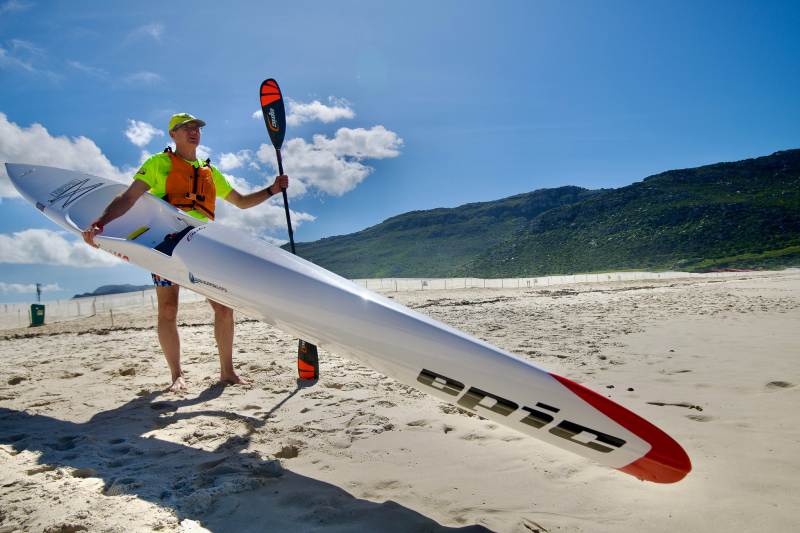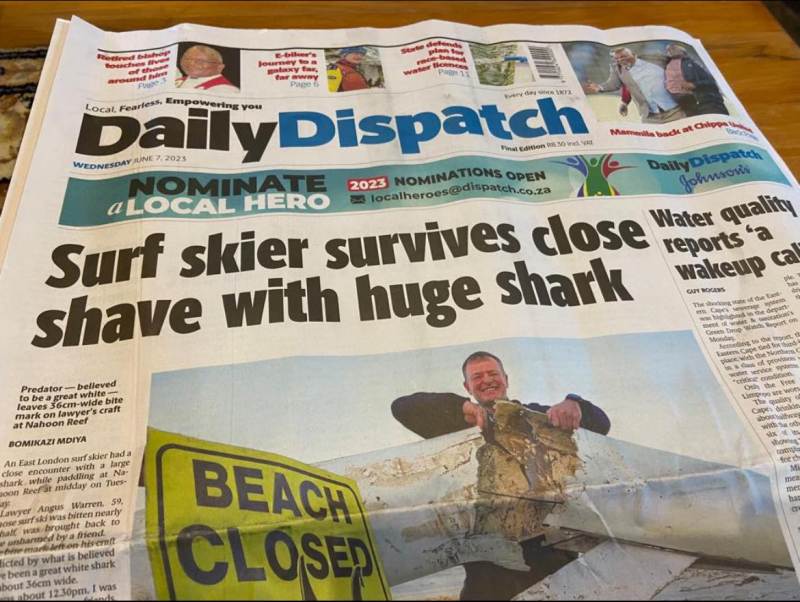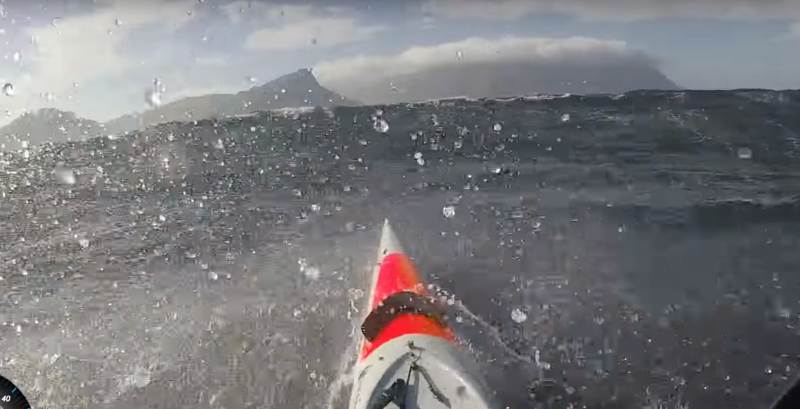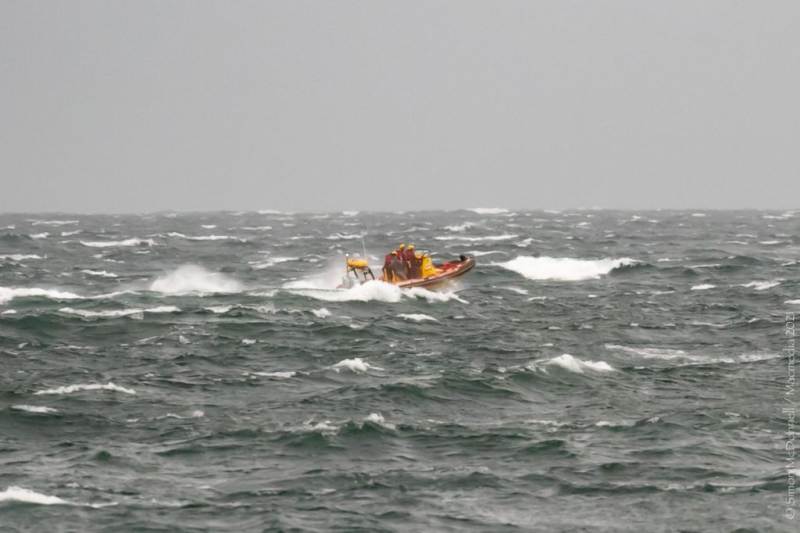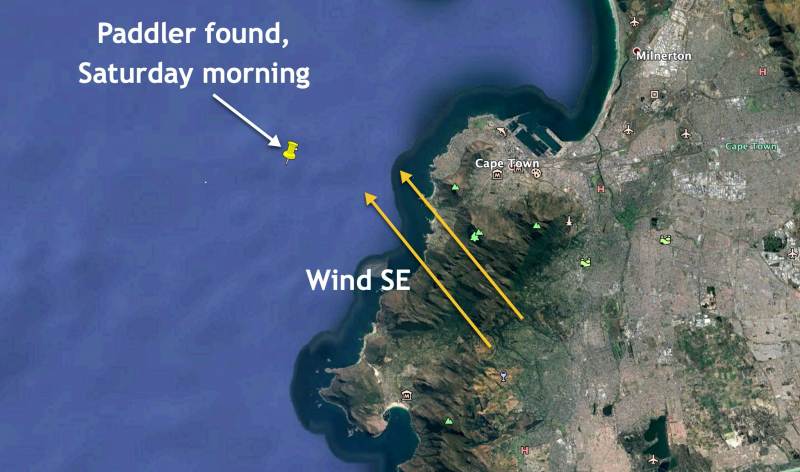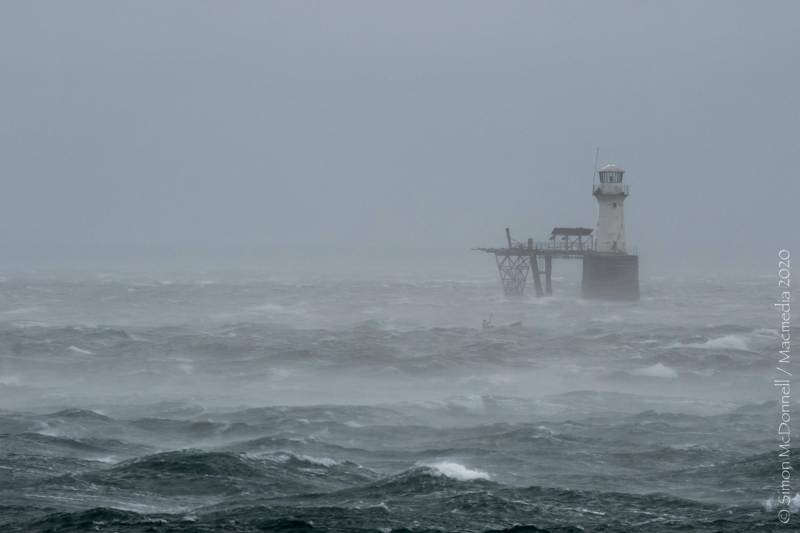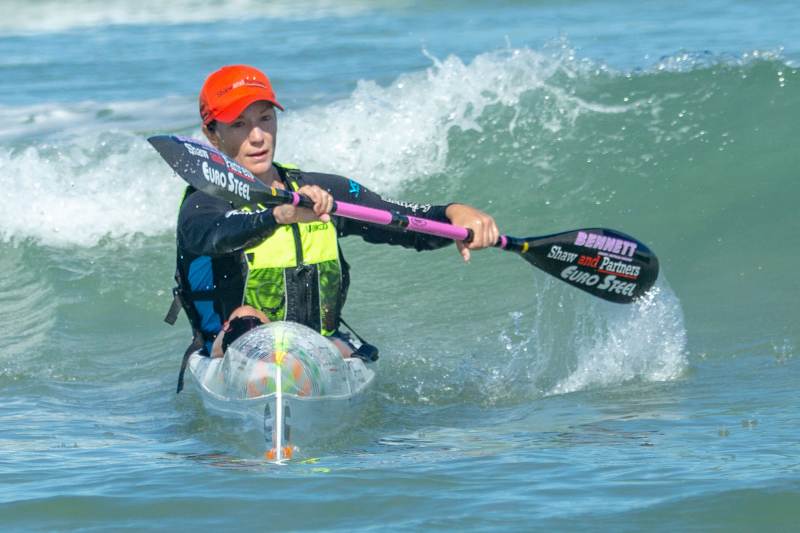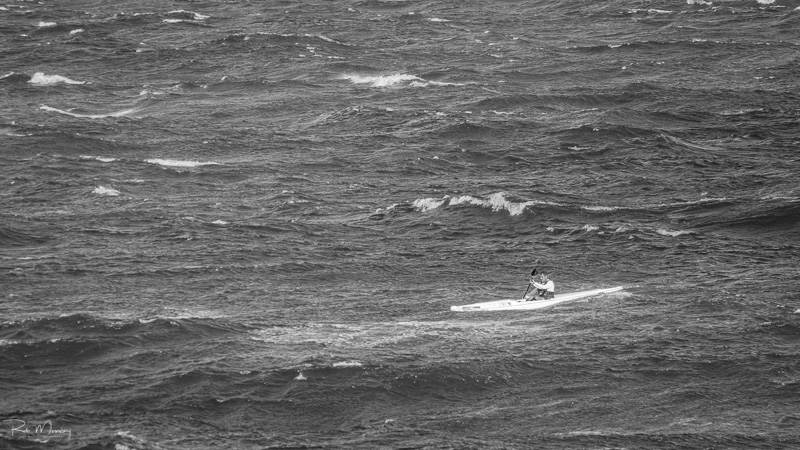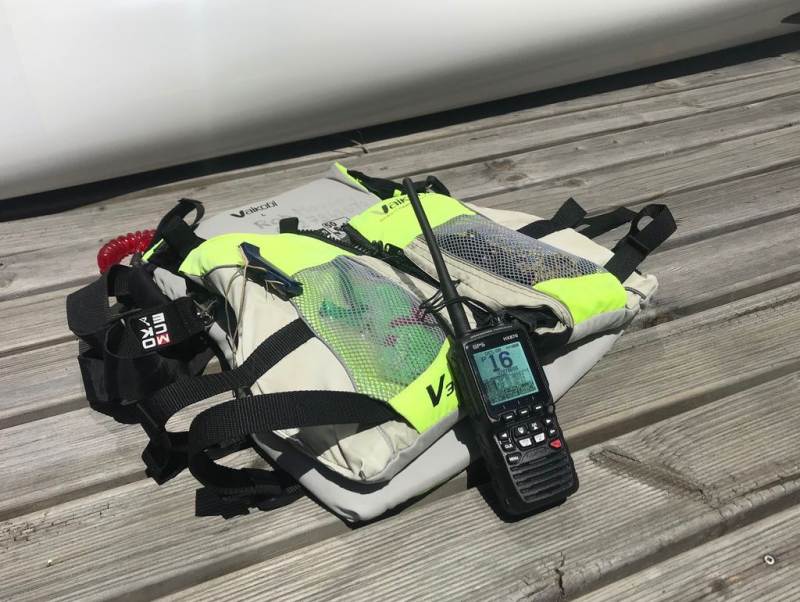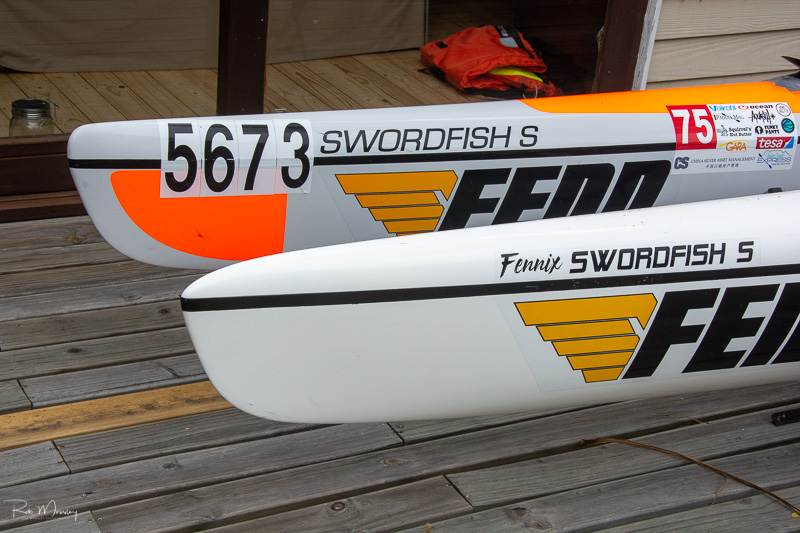Rob Mousley
Epic V10 4G Surfski Review: The Ultimate Intermediate Surfski?
Tuesday, 17 October 2023 07:11 |“What the bloody hell are you doing here?” I thought to myself a few moments after launching on the brand new V10 4G for the first time. It was getting dark; it was raining; the squalls were lifting sheets of spray off the water… directly offshore. What WAS I thinking?
The answer is that I’m a sucker for new toys – and if I get my hands on one, I HAVE to play with it. Damn the weather, full speed ahead…
Since then I’ve paddled the boat many more times, in much pleasanter weather. Here’s what I think of this, the latest in Epic Kayak’s lineup of surfskis.
First Impressions
It was difficult of course to judge the boat on that first paddle; besides the “oh-my-hat-I’d-better-not-lose-it” thoughts, I was too focused on surviving the conditions. But two things were clear: my coccyx was compatible with the seat (hooray!) and the ski was very stable. As I made my way along to the coast, hugging the shoreline, side-on to the gusts, whatever else I was feeling, I wasn’t afraid of falling out.
The next day, when the weather had calmed down, I was able to spend some time examining the boat itself.
Firstly, the build quality is truly extraordinary. Epic Kayaks have been building surfskis since 2005 and have well-deserved reputation for the excellence of their boats’ strength and appearance. The hull is rock-hard, the seams are dead straight, the gel-coat wrinkle free.
The footplate, the well tried and tested tiller bar assembly, the rudder pedals and the rudder itself all scream “quality”.
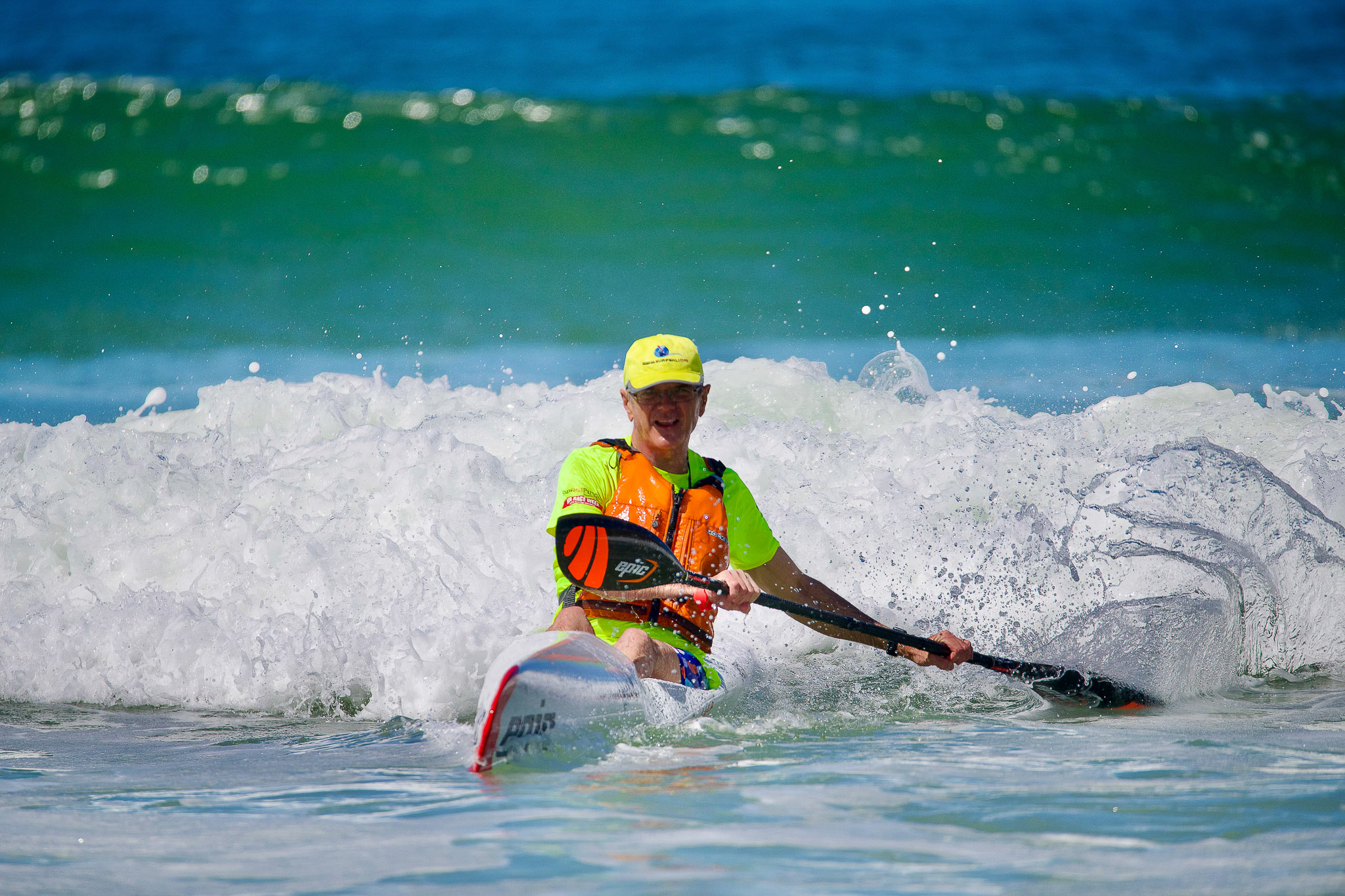
Comfort and Stability – the cockpit
My coccyx is notoriously challenged when it comes to surfski seats: I found my old and beloved Fenn Swordfish S seat so uncomfortable that I had to install a bum pad to stop my backside being rubbed raw; older generations of the V10 had the same issue for me (although to be fair, I seem to be in the minority – most of my buddies don’t suffer the same defect!). In any case, I’m delighted to report that this update of the V10 is compatible with my backside – the seat is one of the most comfortable I’ve ever used.
(Just a side note: I didn’t appreciate just how important comfort is until I paddled the Carbonology Zest X. I had owned an earlier version and was extremely familiar with it. I found the X model to be a significant improvement, but couldn’t figure out whether it had more rocker, less volume or why it handled so much better. The answer – from an amused designer – was simply that the seat had been redesigned. Better comfort; better performance.)
The rails on the V10 4G are low (over 1cm lower than the Swordfish’s for example) and that contributes to the ease of remounting – which I experienced firsthand at the start of a race when I was the only one not to make it over the last wave of an incoming set…
Hull strength
Of course, it’s difficult to assess the strength of any hull until you break it!
But not making it over the last wave of the set described above, was only the beginning… it took me another five minutes, multiple poundings by the next set and another swim finally to get out beyond the break to start my race. The rest of the field had disappeared out of the bay, and I nearly made an expletive-laced quitting decision. (I didn’t and managed to catch the back markers by the half-way mark, and finished happy that I hadn’t come last.)
But here’s the thing: I was very aware that the spectators knew that I was on a brand-new boat. They were delighted by the first wave, which provoked raucous laughter and “helpful” comments – but they became quieter and quieter as my struggle continued. Both they and I were genuinely concerned that the boat might have sustained damage.
Happily, not even a scratch; I was most concerned about the rudder, having been violently thrown backwards by the breakers, but it was undamaged.
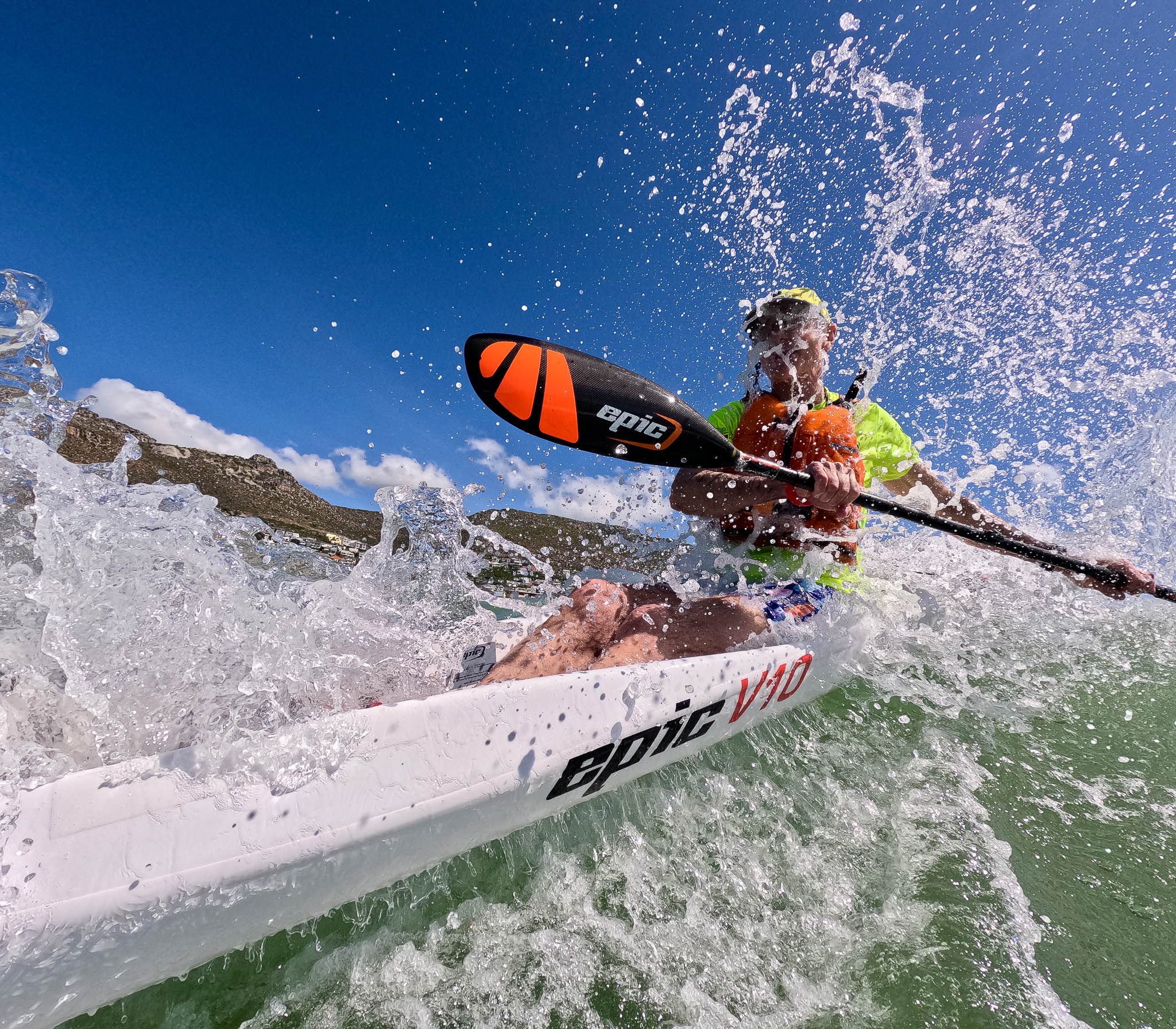
My boat is the “Ultra” layup (11.9kg) – which features a composite skin made of Kevlar fabric, carbon fiber and fiber glass, vacuum bagged over a Nomex honeycomb core and coated with heat-cured epoxy. The result is a rock-hard and seemingly durable hull. No soft spots here.
The “Elite” layup boat (10.6kg) uses the same core but is skinned with 3k carbon fiber.
The boats are listed on the Epic website at $4,695 and $5,295 respectively.
What’s Different about the 4G?
Each iteration of the V10 has led to increased stability – and I find this one phenomenally stable. At my advanced age (60), stability is becoming increasingly important. I feel pretty much bullet-proof in my old Swordfish S – and the same is true of the V10 4G.
The 4G has been given slightly more rocker than its predecessors, but the biggest change, perhaps, is that it’s been given a nose similar to the distinctive shape of the V12 3G: finer, less volume. More on that later.
Epic themselves say that the boat is designed for downwind paddling, the rocker and nose giving “the best downwind performance yet of the V10 series”.
What’s it like to paddle?
One of the joys of Cape Town is that we can paddle the whole year round. In summer the prevailing southeaster powers our famous/notorious Miller’s Run; in winter cold fronts bring northwesters and we simply go the other way. The “Reverse Miller’s” tends to have smaller, cleaner conditions, the conventional Miller’s can vary dramatically – but usually offers bigger, sometimes confused seas.
Suffice to say that I've paddled the V10 in a wide variety of conditions, downwind, upwind and on the flat.
Is it slow on the flat?
You might expect the 4G to be slow – after all it has “increased rocker” plus it’s an “intermediate” boat with the stability associated with greater hull width and consequently, drag, than its slimmer brethren.
What didn’t help was that when the boat arrived, I’d just come out of a series of fitness challenges – injury, covid and surgery – and I wasn’t back to my A-game.
But suffice to say that as the weeks went on, I went from being at the back of our training squad to holding my own with my peer group, even raising some eyebrows during squad sprint intervals.
My conclusion is that the extra width probably does affect the boat – but only in comparison the V12s/V14s of this world and not at the speeds that I paddle at. During those sprints, I was sustaining 11.7-11.9kph, surging onto tiny bumps on the water’s surface. For me, that’s a decent speed. (In any case I regard flat water paddling as a necessary pain – and mere training for downwind.)
"It just kept munching" - Shark Destroys Surfski
Thursday, 08 June 2023 12:42 |East London, South Africa: Angus Warren watched helplessly as the shark’s teeth crunched through the hull of his surfski. “It seemed to go on and on,” he says, “pushing and chomping. I was thinking, why is it not working out that it isn’t food?
“I can’t tell how long it took, but I had enough time to shout a couple of times to the others.”
The next thing he knew, he was in the water…
Thoughts after a Miller's Run
Thursday, 09 February 2023 07:39 |A look back - aaaaargh! A mountain. Let it go through... A smaller one, with a glimpse of something massive lurking further out to sea. Catch it, catch it! Sprint, sprint, you’re on it, here’s the break zone, keep going, keep going, the roar from behind and the sudden acceleration as a massive foamy caught up to me, keep it straight, keep it straight... Phew. Arrived. Panting. Stop the watch. ok. Made it. Empty the boat, pick it up to prevent it knocking you down. Done.
“Not a Standard Miller’s!” – A Rescue Story
Tuesday, 16 March 2021 13:54 |It’s not easy to catch a rolling, runaway single ski in 30kt of gusting wind – and as they attempted to grab it, Alex and his doubles partner lost their balance and fell into the water. By the time they’d remounted, the single ski was gone – blown away by the strengthening near-gale. They turned and paddled back upwind to find their buddy.
Fatal Surfski Accident in Cape Town
Wednesday, 03 March 2021 12:08 |Accident reports are easy to write when the story ends happily, but this one didn’t and it’s with a very heavy heart that I’m writing this, with a view to learning what we can from it.
Paddler Rescued - Thanks to the NSRI and to SafeTRX
Wednesday, 15 July 2020 09:13 |When the NSRI found Duncan MacDonald, he was approximately 6km off Smitswinkel Bay, drifting rapidly further offshore. Gale-force squalls whipped sheets of spray off the waves, reducing visibility almost to nothing.
What Happened?
Given the small size of the surfski community, there’s always intense interest whenever there’s a rescue. What happened? What did they do wrong? What can we learn from it?
Clearly there are lessons to be learnt from any mishap – so here’s a description of what happened, shared with the permission and cooperation of the folks involved in the hope that we might all learn from this incident.
Reverse Miller’s Run
During the morning of 9 July 2020, a constant stream of paddlers had launched off the beach at Fish Hoek to paddle with the wind and waves to Miller’s Point, just under 11km down the coast. Hundreds of paddlers cover this route, the “Reverse Miller’s Run” every winter, setting off whenever a cold front triggers the NW wind.
On this day, the wind had been extreme: gale-force at times, 30kt gusting to 40 or 45kt. But the NNW direction had been perfect, and at 9am the record for the run had been broken by Jasper Mocke, in a time of 36:55. (I too broke my personal record, in a much more pedestrian 42:58.)
By 1pm, the wind had dropped to around 15kt, gusts of 20-25kt. The direction had changed slightly, the weather station at Fish Hoek showing that it was more NW that the earlier NNW. The forecast had predicted that it would swing due west, but it wasn’t anything like that yet.
Duncan MacDonald, Thomas Altmann and Michael Thorpe set off into the relatively benign conditions. Knowing that the wind was forecast to swing west later in the afternoon, they initially hugged the coast, bearing right out of Fish Hoek bay to get on a more inshore line than usual.
“The wind direction was fine as we exited the bay,” said Altmann. “There was none of the side-on chop that you sometimes get.”
The further they got from shore, the bigger the waves and soon they were surfing gleefully down the faces…
Being the least experienced of the three paddlers, MacDonald was keeping an eye out for the two in front. “I deliberately stayed well inside Michael,” he said. “So, I thought I was on a safe line.”
Conditions Change
Past the lighthouse, the men had the finish at Miller’s Point in sight, when suddenly the wind strength increased dramatically. At the same time, the shore faded from view, hidden by a combination of the squalls, mist and rain…
What the men didn’t at first appreciate was how much the wind direction had changed as well.
Both MacDonald and Altmann commented that as soon as the conditions changed, they had instinctively altered course towards land – or so they thought. In fact, they were fooled by the wind direction: although they were now paddling partly side-on to the wind, the change in the wind direction meant that at best they were paddling parallel to the shore, not towards it.
“Our depth perception was affected by the bad visibility,” said MacDonald. “I certainly didn’t realize how far offshore we were.”
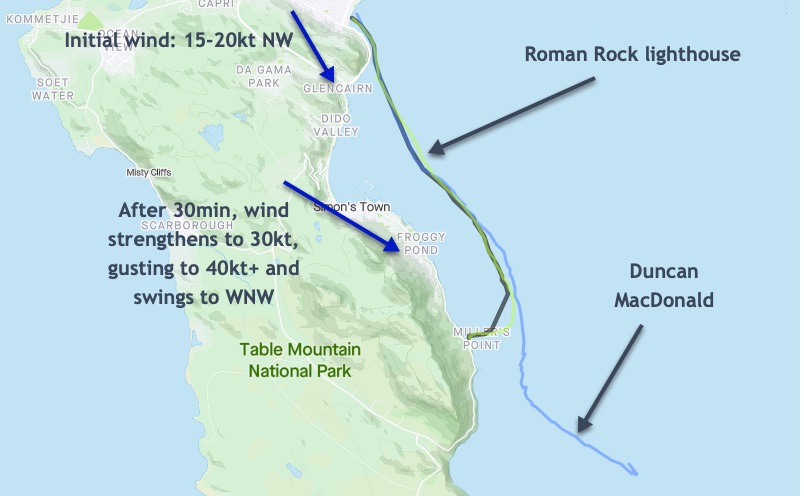
The paddlers' tracks as shown on Strava
Miller’s Point
After catching a brief glimpse of the buildings just before Miller’s Point, Altmann realized that he was on the verge of over-shooting the finish.
Turning hard right, he battled, side-on to the wind and waves, to fight his way to shore. “If you zoom in on the Strava track, you can see where the wind blew me off course every time a squall came through,” he said.
At the ramp, Vincent Cicatello was waiting for the paddlers to arrive. Anxious, he put a call through to the NSRI. He could see two of the paddlers, but they were in the wrong place and were overdue. He wasn’t sure, he told the NSRI, but there might be a problem.
Altmann and then Thorpe finally made it around the breakwater – but MacDonald was nowhere in sight and they decided to call the NSRI to raise the alarm.
SafeTRX
At almost the same time, the NSRI Emergency Operations Centre (EOC) received an emergency notification from SafeTRX – a mobile phone tracking app that many of the paddlers use.
MacDonald, realizing that he’d passed Miller’s Point and finding himself unable to make any headway towards land had made the decision to call for help and had triggered the app.
“From my GPS I knew that I had travelled 11km,” he said, “and that meant I was past Miller’s Point – although I couldn’t see it.”
Things started to change rapidly: the coast curves south at that point and he was being blown further offshore. Conditions were becoming more extreme, squall following squall as he neared the area known by the paddlers as “hurricane alley”, a notorious area where westerly winds are funneled into howling torrents between two peaks.
“My choices were to continue to try to paddle in and perhaps land at Smitswinkel Bay, or to call for help,” he said. While he was able to make some headway in the lulls, he could hardly hang to his paddle when the squalls hit. Rather than exhaust himself, he opted to make the emergency call.
He tapped the "Call for Help" button on the app and within moments was through to the NSRI Ops Room. They told him they were activating NSRI Simon's Town and rang off. He'd had the app on the lowest power setting, updating every 10 minutes, but it now automatically switched to the "Alert and Track" mode, updating at 5min intervals.
"Hitting the button was simple," he said. "The call was ok, hearing them was fine, but with the wind noise, they struggled to hear me."
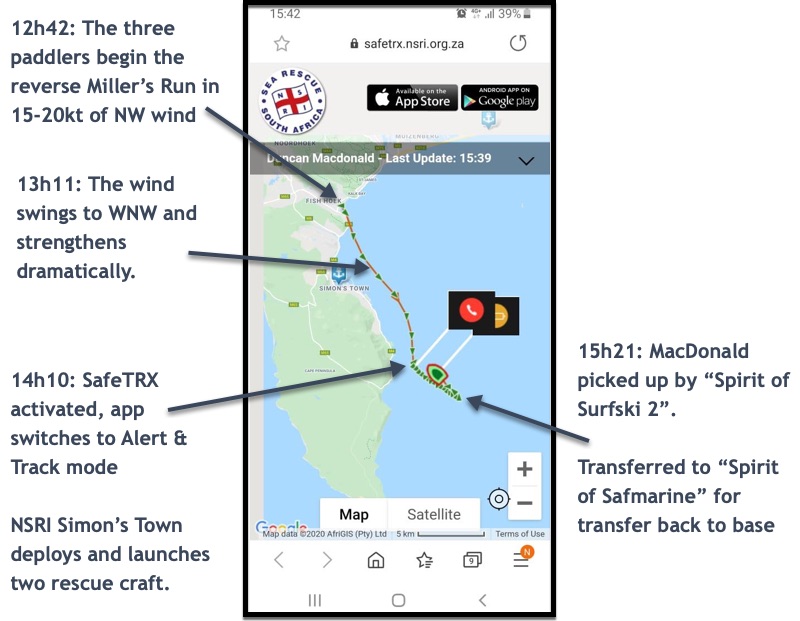
Duncan MacDonald's track as seen on his buddy's phone
At that point, his approach became one of survival. “I wanted to stay on the boat – for warmth and to be more visible,” he said. “The Blue-fin is very stable, and with my legs over the side, I could sit there forever.”
And it felt like forever. “I lost all sense of time,” he said. “In the moment it felt like time stood still.
“But it was probably around 45 minutes later when I saw the NSRI rescue boat approaching.”
By that time, he’d drifted approximately 6km off Smitswinkel Bay in the midst of growing seas and sheeting squalls.
The last 400m
“Your emotions are interesting out there,” he said. “After I’d called for help, I wasn’t really worried – until they went past without seeing me! Then it was ‘what if they can’t find you…’ There’s that doubt in your mind.”
At that moment he was on the phone to Altmann. Altmann relayed the message to the NSRI who then called MacDonald directly and he was able to guide them to his location.
The NSRI crew loaded MacDonald onto the “Spirit of Surfski 2” RIB and took him across to the big "Spirit of Safmarine" rescue craft where he was transferred for the trip back to the Simon’s Town base. Having been warmed up and assessed, no further medical treatment was necessary.
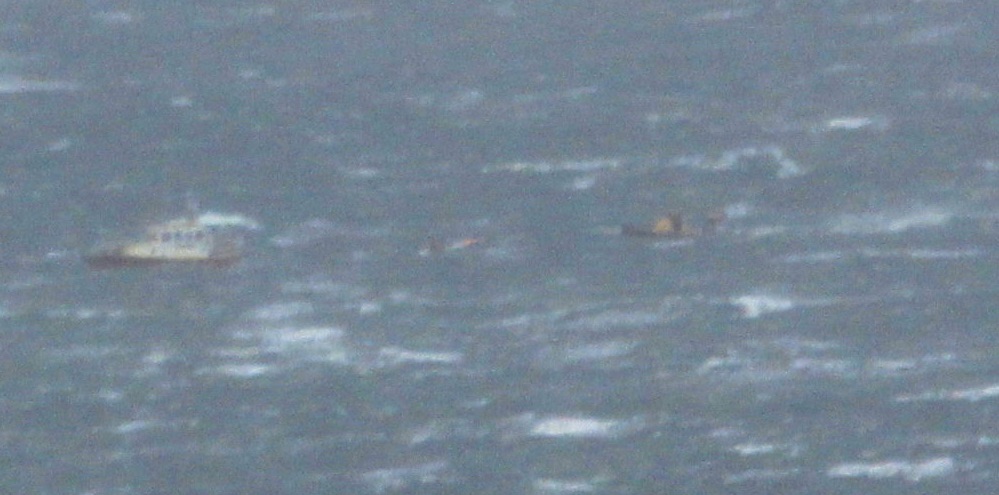
The two NSRI rescue craft find the surfski (centre) some 6km out to sea (Pic: Douglas Drysdale)
Paddler-Aid for Covid-19 Victims
Friday, 24 April 2020 11:41 |Durban – As the continued coronavirus lockdown grips the country, Canoeing South Africa will host a 24 hour Canoeing4COVID-19 event this weekend as a way to raise funds for members of the broader paddling community that have been badly affected by the lockdown.
Lessons from the Edge
Wednesday, 11 March 2020 14:35 |“Hey, Rob! Help!” The shouts penetrated the sound of the howling wind and crashing waves – and even through the noise it was obvious from the tone of his voice that something was seriously wrong. I turned and headed back upwind.
Review: Standard Horizon HX870 Handheld VHF Radio - UPDATED
Tuesday, 03 March 2020 14:43 |Many paddlers use Personal Locator Beacons, or tracker apps like SafeTrx on their mobile phones. But handheld VHF radios are also a great choice to consider – especially when they’re DSC-capable like the Standard Horizon HX870E.
Fennix Swordfish S - First Looks
Monday, 24 February 2020 12:01 |I finally got my hands on a demo Fennix Swordfish S this weekend and did two Miller's Runs in succession to see if I could feel any difference in handling between the 2018 Swordfish S and the new Fennix model. Conditions were challenging: False Bay was covered in whitecaps, whipped by a combination of a 25-30kt southeaster and small, confused seas. The result? I definitely want to spend more time in this boat.
Latest Forum Topics
-
- Surfski Width x Length Chart - 5th March 2025
- 4 days 20 hours ago
-
- Nelo models getting confusing
- 6 days 10 hours ago


